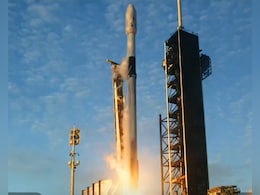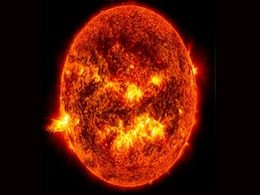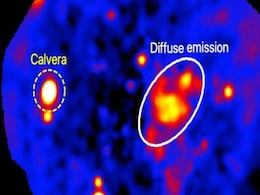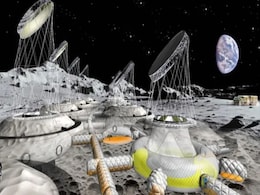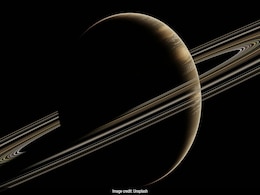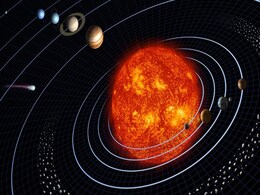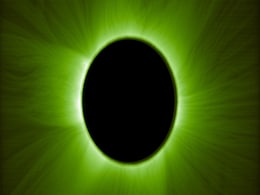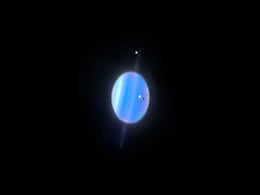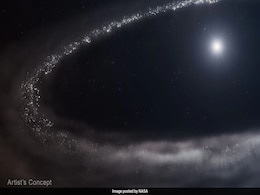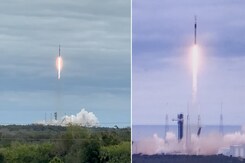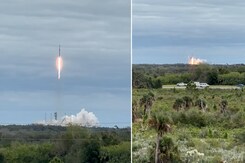Outer Space
- All
- News
- Videos
- Photos
-

Scientists Detect Hidden Magnetic Waves That Could Explain the Sun’s Mysterious Heat
- Sunday November 2, 2025
- Written by Gadgets 360 Staff
For the first time, scientists have directly observed twisting Alfvén waves in the Sun’s corona using the Inouye Solar Telescope. The discovery could explain why the Sun’s outer atmosphere is millions of degrees hotter than its surface, offering key insights into solar energy transfer and space weather prediction.
-
 www.gadgets360.com
www.gadgets360.com
-

SpaceX Launches IMAP, CGO, SWFO-L1 to Probe Solar Frontier and Space Weather
- Sunday September 28, 2025
- Written by Gadgets 360 Staff
A Falcon 9 lifted off from Kennedy Space Center on Sept. 24, 2025, carrying NASA’s IMAP, CGO, and SWFO-L1 spacecraft. The mission aims to chart the heliosphere’s boundary, monitor Earth’s geocorona, and deliver constant space-weather alerts, protecting satellites and astronauts while expanding knowledge of the solar system’s outer edge.
-
 www.gadgets360.com
www.gadgets360.com
-

NASA and NOAA Set to Launch Solar Probes for Space Weather Forecasting
- Friday September 5, 2025
- Written by Gadgets 360 Staff
In Sept. 2025, NASA and NOAA will launch three spacecraft aboard a Falcon 9 to the Sun–Earth L1 point. IMAP will map the heliosphere’s edge, the Carruthers Geocorona Observatory will study Earth’s exosphere, and SWFO-L1 will deliver real-time solar storm warnings. Together, they aim to improve space-weather science and safeguard technology on...
-
 www.gadgets360.com
www.gadgets360.com
-

Astronomers Discover Calvera, a Runaway Pulsar Racing Above the Milky Way
- Wednesday September 3, 2025
- Written by Gadgets 360 Staff
Astronomers have discovered Calvera, a pulsar speeding 6,500 light-years above the Milky Way’s disk. Formed from a supernova in a nearly empty region, Calvera challenges long-held ideas of star birth and death. Its discovery reveals that extreme stellar events can occur even in the galaxy’s sparse outer halo.
-
 www.gadgets360.com
www.gadgets360.com
-

NASA Unveils Plans for Lunar Nuclear Reactor by 2030 Amid Rising Moon Race
- Monday September 1, 2025
- Written by Gadgets 360 Staff
NASA plans to build a 100-kilowatt nuclear fission reactor on the Moon’s south pole by 2030 to power Artemis missions and future lunar bases. The site offers access to water ice but raises legal and diplomatic concerns under the Outer Space Treaty. With China and Russia advancing their own lunar power plants, the move from the US.
-
 www.gadgets360.com
www.gadgets360.com
-

NASA To Build Nuclear Reactor On Moon By 2030, Here's Why
- Monday August 11, 2025
- World News | The Conversation
The first space race was about flags and footprints. Now, decades later, landing on the Moon is old news. The new race is to build there, and doing so hinges on power.
-
 www.ndtv.com
www.ndtv.com
-

NASA Wants Nuclear Reactor On Moon By 2030. Here's Why That Matters
- Friday August 8, 2025
- World News | Associated Press
Nuclear power in space isn't a new idea. Since the 1960s, the US and the Soviet Union have relied on radioisotope generators that use small amounts of radioactive elements to power satellites.
-
 www.ndtv.com
www.ndtv.com
-

Study Reveals What Presence Of CO2 On Eight Saturn Moons Means
- Tuesday July 29, 2025
- Science | Edited by Srishti Singh Sisodia
The study aims to help scientists understand the existence of CO2 on planetary bodies, the process of formation and evolution.
-
 www.ndtv.com
www.ndtv.com
-

Did Something Hit Saturn? Astronomers Investigate Possible Impact Flash
- Wednesday July 9, 2025
- Science | Edited by Amit Chaturvedi
Unlike rocky planets where asteroid impacts leave visible craters, gas giants like Saturn have outer layers of hydrogen and helium that can absorb impacts without obvious traces.
-
 www.ndtv.com
www.ndtv.com
-

Meteorite From Outer Solar System Challenges Planet Formation Timeline in Early Solar System
- Saturday July 12, 2025
- Written by Gadgets 360 Staff
A meteorite from the outer solar system may upend long-held beliefs about planetary formation. New research shows rocky planets like Earth may have formed at the same time as those beyond Jupiter. The findings challenge previous models and suggest a more synchronised origin for rocky worlds across the solar system, with major implications for plane...
-
 www.gadgets360.com
www.gadgets360.com
-

Two Spacecraft Recreate Artificial Solar Eclipses to Observe the Sun’s Superhot Corona
- Friday June 27, 2025
- Written by Gadgets 360 Staff
Twin satellites in ESA’s Proba-3 mission have successfully recreated artificial solar eclipses from space to examine the sun’s million-degree corona. The breakthrough will allow continuous observations of the sun’s outer atmosphere, offering rare insights that natural eclipses on Earth can’t provide. The mission marks a major step in solar ...
-
 www.gadgets360.com
www.gadgets360.com
-

Hubble Finds Cosmic Dust Coating Uranus’ Moons, Not Radiation Scars
- Thursday June 12, 2025
- Written by Gadgets 360 Staff
New Hubble Space Telescope observations have upended decades of expectations about Uranus’ moons. Scientists once thought the planet’s magnetic field darkened their backsides with radiation, but the latest data shows Titania and Oberon are collecting space dust on their leading sides instead. This “cosmic bug splatter” effect suggests dust ...
-
 www.gadgets360.com
www.gadgets360.com
-

James Webb Telescope Detects Frozen Water In Young Star System For The First Time
- Tuesday June 3, 2025
- Science | Edited by Ritu Singh
This finding has opened up new avenues for understanding the early universe and the origins of water on our planet
-
 www.ndtv.com
www.ndtv.com
-

Scientists Capture Plasma Streams, Coronal Raindrops in Sharpest-Ever View of Sun’s Corona
- Saturday May 31, 2025
- Written by Gadgets 360 Staff
For the first time, scientists have captured ultra-detailed footage of the sun’s outer atmosphere, showing coronal rain and a never-before-seen plasma stream. These new images were made possible by adaptive optics that cut through Earth’s atmospheric interference, revealing structures never observed before. The findings could unlock solar myste...
-
 www.gadgets360.com
www.gadgets360.com
-

Scientists Detect Hidden Magnetic Waves That Could Explain the Sun’s Mysterious Heat
- Sunday November 2, 2025
- Written by Gadgets 360 Staff
For the first time, scientists have directly observed twisting Alfvén waves in the Sun’s corona using the Inouye Solar Telescope. The discovery could explain why the Sun’s outer atmosphere is millions of degrees hotter than its surface, offering key insights into solar energy transfer and space weather prediction.
-
 www.gadgets360.com
www.gadgets360.com
-

SpaceX Launches IMAP, CGO, SWFO-L1 to Probe Solar Frontier and Space Weather
- Sunday September 28, 2025
- Written by Gadgets 360 Staff
A Falcon 9 lifted off from Kennedy Space Center on Sept. 24, 2025, carrying NASA’s IMAP, CGO, and SWFO-L1 spacecraft. The mission aims to chart the heliosphere’s boundary, monitor Earth’s geocorona, and deliver constant space-weather alerts, protecting satellites and astronauts while expanding knowledge of the solar system’s outer edge.
-
 www.gadgets360.com
www.gadgets360.com
-

NASA and NOAA Set to Launch Solar Probes for Space Weather Forecasting
- Friday September 5, 2025
- Written by Gadgets 360 Staff
In Sept. 2025, NASA and NOAA will launch three spacecraft aboard a Falcon 9 to the Sun–Earth L1 point. IMAP will map the heliosphere’s edge, the Carruthers Geocorona Observatory will study Earth’s exosphere, and SWFO-L1 will deliver real-time solar storm warnings. Together, they aim to improve space-weather science and safeguard technology on...
-
 www.gadgets360.com
www.gadgets360.com
-

Astronomers Discover Calvera, a Runaway Pulsar Racing Above the Milky Way
- Wednesday September 3, 2025
- Written by Gadgets 360 Staff
Astronomers have discovered Calvera, a pulsar speeding 6,500 light-years above the Milky Way’s disk. Formed from a supernova in a nearly empty region, Calvera challenges long-held ideas of star birth and death. Its discovery reveals that extreme stellar events can occur even in the galaxy’s sparse outer halo.
-
 www.gadgets360.com
www.gadgets360.com
-

NASA Unveils Plans for Lunar Nuclear Reactor by 2030 Amid Rising Moon Race
- Monday September 1, 2025
- Written by Gadgets 360 Staff
NASA plans to build a 100-kilowatt nuclear fission reactor on the Moon’s south pole by 2030 to power Artemis missions and future lunar bases. The site offers access to water ice but raises legal and diplomatic concerns under the Outer Space Treaty. With China and Russia advancing their own lunar power plants, the move from the US.
-
 www.gadgets360.com
www.gadgets360.com
-

NASA To Build Nuclear Reactor On Moon By 2030, Here's Why
- Monday August 11, 2025
- World News | The Conversation
The first space race was about flags and footprints. Now, decades later, landing on the Moon is old news. The new race is to build there, and doing so hinges on power.
-
 www.ndtv.com
www.ndtv.com
-

NASA Wants Nuclear Reactor On Moon By 2030. Here's Why That Matters
- Friday August 8, 2025
- World News | Associated Press
Nuclear power in space isn't a new idea. Since the 1960s, the US and the Soviet Union have relied on radioisotope generators that use small amounts of radioactive elements to power satellites.
-
 www.ndtv.com
www.ndtv.com
-

Study Reveals What Presence Of CO2 On Eight Saturn Moons Means
- Tuesday July 29, 2025
- Science | Edited by Srishti Singh Sisodia
The study aims to help scientists understand the existence of CO2 on planetary bodies, the process of formation and evolution.
-
 www.ndtv.com
www.ndtv.com
-

Did Something Hit Saturn? Astronomers Investigate Possible Impact Flash
- Wednesday July 9, 2025
- Science | Edited by Amit Chaturvedi
Unlike rocky planets where asteroid impacts leave visible craters, gas giants like Saturn have outer layers of hydrogen and helium that can absorb impacts without obvious traces.
-
 www.ndtv.com
www.ndtv.com
-

Meteorite From Outer Solar System Challenges Planet Formation Timeline in Early Solar System
- Saturday July 12, 2025
- Written by Gadgets 360 Staff
A meteorite from the outer solar system may upend long-held beliefs about planetary formation. New research shows rocky planets like Earth may have formed at the same time as those beyond Jupiter. The findings challenge previous models and suggest a more synchronised origin for rocky worlds across the solar system, with major implications for plane...
-
 www.gadgets360.com
www.gadgets360.com
-

Two Spacecraft Recreate Artificial Solar Eclipses to Observe the Sun’s Superhot Corona
- Friday June 27, 2025
- Written by Gadgets 360 Staff
Twin satellites in ESA’s Proba-3 mission have successfully recreated artificial solar eclipses from space to examine the sun’s million-degree corona. The breakthrough will allow continuous observations of the sun’s outer atmosphere, offering rare insights that natural eclipses on Earth can’t provide. The mission marks a major step in solar ...
-
 www.gadgets360.com
www.gadgets360.com
-

Hubble Finds Cosmic Dust Coating Uranus’ Moons, Not Radiation Scars
- Thursday June 12, 2025
- Written by Gadgets 360 Staff
New Hubble Space Telescope observations have upended decades of expectations about Uranus’ moons. Scientists once thought the planet’s magnetic field darkened their backsides with radiation, but the latest data shows Titania and Oberon are collecting space dust on their leading sides instead. This “cosmic bug splatter” effect suggests dust ...
-
 www.gadgets360.com
www.gadgets360.com
-

James Webb Telescope Detects Frozen Water In Young Star System For The First Time
- Tuesday June 3, 2025
- Science | Edited by Ritu Singh
This finding has opened up new avenues for understanding the early universe and the origins of water on our planet
-
 www.ndtv.com
www.ndtv.com
-

Scientists Capture Plasma Streams, Coronal Raindrops in Sharpest-Ever View of Sun’s Corona
- Saturday May 31, 2025
- Written by Gadgets 360 Staff
For the first time, scientists have captured ultra-detailed footage of the sun’s outer atmosphere, showing coronal rain and a never-before-seen plasma stream. These new images were made possible by adaptive optics that cut through Earth’s atmospheric interference, revealing structures never observed before. The findings could unlock solar myste...
-
 www.gadgets360.com
www.gadgets360.com


